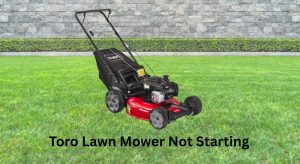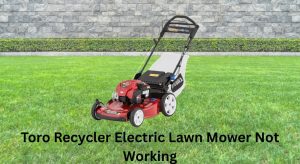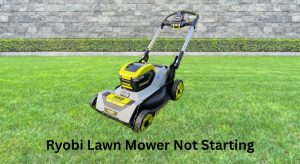Cold months are hard on small engines. If your lawn mower will not start after winter, you’re not alone—and the fix is often simpler than you think. The quickest solution many homeowners find success with is fresh fuel and a new spark plug. In 10–20 minutes, you can swap stale gas for new, prime the engine, and replace the plug to get your mower roaring back to life.
In this complete guide, you’ll learn every proven method to bring a gas lawn mower back after storage: quick-start tricks, carburetor cleaning, fuel system fixes, battery checks for electric-start models, and the maintenance steps that prevent spring startup headaches. Whether you have a push mower with a primer bulb, a choke-only model, or a riding mower with electric start, you’ll have a clear path to a reliable start today.
Common Causes of a Lawn Mower Not Starting After Winter
- Stale or ethanol-separated fuel
- Clogged carburetor jets or stuck float
- Fouled or incorrect spark plug
- Dirty air filter or mouse nests in the air box
- Fuel filter or fuel line blockage
- Weak/bad battery (riding mowers/electric start)
- Faulty safety switches (blade control, seat, brake)
- Water or condensation in the fuel tank
- Oil too thick or low oil shutoff engaged
- Flooded engine from over-priming
How to Fix a Lawn Mower that Will Not Start After Winter

Method 1: The 10-Minute Quick Start (Fuel and Spark Basics)
Best for: First try after storage; most walk-behind mowers
Time: 10–20 minutes
Tools: Socket for spark plug (usually 13/16″ or 5/8″), funnel, paper towels, new fuel
Diagnosing the Issue
- Symptoms: No sputter at all, or brief fire then stall.
Fix Steps
1) Drain stale fuel:
– Tip the mower carefully or use a siphon pump. Dispose properly.
2) Refill with fresh gasoline:
– Use regular unleaded 87–91 octane, ideally ethanol-free or with a stabilizer.
3) Prime correctly:
– Press the primer bulb 3–5 times (if equipped). If you have a manual choke, move to “Choke.”
4) Replace the spark plug:
– Remove and inspect. If black and oily or corroded, replace. Gap to 0.028–0.030″ (check engine manual).
5) Check air filter:
– Paper filters: Tap out debris or replace if dark and clogged. Foam filters: Wash, dry, lightly oil.
6) Start attempt:
– Pull firmly 2–3 times. If it coughs, move choke to “Run” and continue.
Testing
- If it starts and runs smoothly, let it warm up for 5 minutes. If it starts then dies, move to Method 2.
Method 2: Unflood the Engine and Set the Choke Right
Best for: Engine smells like gas, plug is wet, or you primed too much
Time: 5–10 minutes
Diagnosing the Issue
- You smell fuel strongly; plug tip is wet; pulls are easy but no fire.
Fix Steps
1) Turn fuel valve off (if present).
2) Remove spark plug; pull starter 5–10 times to clear cylinder.
3) Dry or replace plug; re-gap if needed.
4) Throttle to “Run” (not “Choke”), full throttle if lever exists.
5) Reinstall plug and try to start without priming. Turn fuel back on.
Testing
- Starts after 2–4 pulls. If not, move on.
Method 3: Carburetor Clean (Jet and Bowl Service)
Best for: Starts on starter fluid but dies, or surging/only runs on choke
Time: 30–60 minutes
Tools: Screwdrivers, 10mm/12mm sockets, carb cleaner, small wire/brush, gloves, safety glasses
Important: Work in a ventilated area. Avoid spraying near ignition sources.
Diagnosing the Issue
- Runs only on choke, stalls under load, or won’t stay running—classic sign of clogged main jet.
Fix Steps
1) Shut off fuel valve or clamp fuel line. Disconnect spark plug wire.
2) Remove air filter housing and carburetor bowl:
– Loosen the bowl bolt at bottom of carb. Catch fuel in a container.
3) Clean jets and bowl:
– The bowl bolt often has a tiny metering hole—clear it with a wire and carb cleaner.
– Spray carb jets and passages. Do not damage soft gaskets.
4) Inspect float and needle:
– Ensure float moves freely; clean the needle tip and seat.
5) Reassemble:
– Replace bowl gasket if cracked. Refit air box and filter.
6) Optional: Replace in-line fuel filter and cracked fuel lines.
Testing
- Prime 2–3 times; start. It should idle without choke. If still surging, repeat cleaning or consider a carburetor rebuild/replace.
Method 4: Fuel System Refresh and Water Removal
Best for: Mowers sat with ethanol gas; suspected water in tank
Time: 20–40 minutes
Tools: Siphon, fresh gas, fuel stabilizer, Seafoam or carb cleaner additive
Diagnosing the Issue
- Mower tries to start but sputters; you see water beads in drained fuel.
Fix Steps
1) Fully drain tank and carb bowl.
2) Refill with fresh gasoline plus fuel stabilizer (per label).
3) Add fuel system cleaner (Seafoam/Techron small engine dosage).
4) Prime and start; let it run 10–15 minutes to clear varnish.
Testing
- Smooth running after warm-up. If performance is still poor, move to air or spark checks.
Method 5: Ignition and Safety Switch Checks
Best for: Riding mowers/electric start; no crank or crank-no-start
Time: 15–45 minutes
Tools: Multimeter, battery charger, wrenches
Diagnosing the Issue
- No crank: Turn key and hear click or nothing at all.
- Crank-no-start: Spins but won’t fire; may be spark-related.
Fix Steps (No Crank)
1) Battery:
– Measure DC voltage: Healthy is 12.6V+ at rest. Charge if 12.2V or less.
– Clean battery terminals; tighten connections.
2) Safety switches:
– Seat switch (must be seated), brake/clutch switch (pedal depressed), blade/PTO off.
– Wiggle levers while turning key to detect intermittent switches.
3) Fuses and solenoid:
– Check main fuse near starter solenoid; replace if blown.
– Tap solenoid lightly; corroded solenoids can stick.
4) Starter motor test:
– If voltage reaches starter but no spin, starter may be faulty.
Fix Steps (Crank-No-Start)
1) Spark:
– Remove plug, ground it to engine, crank—look for strong blue spark.
– No spark: Replace plug, check coil/kill wire; ensure safety systems aren’t grounding ignition.
2) Fuel:
– Spray a brief shot of starting fluid into intake; if it fires and dies, suspect carb/fuel delivery (see Method 3).
3) Compression:
– If pull cord is unusually easy and no pop, compression may be low (valve/cylinder issue—professional time).
Testing
- Once it runs, warm up and verify restart.
Method 6: Air Intake and Mouse Nest Cleanup
Best for: No start or rough running, muffled intake sound after storage
Time: 10–25 minutes
Tools: Screwdriver, shop vac
Diagnosing the Issue
- Air filter box stuffed with grass or nesting; filter chewed or soaked with oil.
Fix Steps
1) Remove air filter cover and filter.
2) Vacuum debris; ensure intake snorkel is clear.
3) Replace filter if saturated, torn, or mouse-damaged.
Testing
- With clean airflow, engine should run stronger and start easier.
Method 7: Oil Check and Low-Oil Shutoff
Best for: Honda and some other engines with low-oil safety
Time: 5 minutes
Fix Steps
1) Check oil level on flat ground; top up with correct viscosity (SAE 10W-30 is common).
2) If oil is thick or milky (water contamination), change it before running.
Testing
- Low-oil shutdown will prevent spark. Correcting level allows normal start.
Prevention Tips and Maintenance Advice
- Always add fuel stabilizer to the last tank of the season and run 5–10 minutes before storage.
- Store with an empty tank and drained carb bowl—OR completely full with stabilized ethanol-free fuel to reduce condensation.
- Replace spark plug annually or every 100 hours.
- Keep air filter clean; replace paper filters every season if dusty.
- Use ethanol-free fuel if available, or keep gas fresh (within 30 days) and stabilized.
- Charge and maintain riding mower batteries with a smart maintainer over winter.
- Before first mow in spring, do a full tune-up: oil, plug, filter, blade sharpening.
Why Your Lawn Mower Will Not Start After Winter: Deeper Causes Explained
Stale/Ethanol Fuel
Modern E10 fuel absorbs water and can separate in 60–90 days, leaving varnish that clogs jets. Using stabilizer and rotating fuel stock prevents this.
Fouled Spark Plug
Short runs and cold starts foul plugs. A fresh, correctly gapped plug restores strong ignition and easier starts.
Clogged Carburetor
Gummed jets restrict fuel at idle and transition circuits, causing “starts on choke only” behavior.
Battery Sulfation (Riding Mowers)
Sitting at low charge causes sulfation and weak cranking. Keep batteries on a maintainer.
Safety Interlocks
Blade/PTO, seat, and brake switches prevent starting in unsafe conditions. Corrosion or misalignment can block starts.
Pro Tips
- Use a carburetor cleaning tool kit with micro files for precise jet cleaning without enlarging orifices.
- Replace the fuel line and add an inline shutoff valve—handy for draining bowls before storage.
- Mark a small date on your air filter and spark plug at install time; replace on schedule.
- If your mower only runs on choke after cleaning, check for intake gasket air leaks—spray carb cleaner around the intake while running; RPM change indicates a leak.
- For pull-start mowers, a few drops of fresh gas in the spark plug hole can help confirm ignition while you address fuel delivery.
- Avoid over-priming; excess fuel floods and washes cylinder oil. If flooded, open throttle and wait 10 minutes before retrying.
- Keep a fresh pre-mixed quart of ethanol-free fuel for first starts each spring.
Professional Help: When to Call a Pro
- Repeated no-start after fresh fuel, new plug, and carb cleaning
- Fuel leaking from carburetor (stuck float/needle seat replacement needed)
- Electrical diagnosis on riding mowers beyond battery/fuses (starter, solenoid, wiring)
- Low compression suspected (broken ring, valve issues, bent pushrod)
- Blade engagement or transmission interlock faults on tractors
What to look for:
– Technicians certified in Briggs & Stratton, Honda, Kohler, or Kawasaki engines
– Transparent diagnostic fee applied to repair
– Parts warranty (30–90 days) and labor guarantee
Typical costs:
– Basic tune-up (walk-behind): $80–$150
– Carburetor clean/rebuild: $90–$180
– New carburetor: $40–$120 part + labor
– Riding mower battery: $40–$120
– Starter/solenoid replacement: $100–$250 total
Warranty notes:
– Don’t disassemble under warranty without checking terms; use authorized service centers.
FAQ
Q: Can I use last year’s gas?
A: Not recommended. Gas older than 60–90 days can cause hard starts and clogs, especially E10. If you must, mix small amounts with fresh fuel and use a stabilizer, but fresh is best for first starts.
Q: My mower only runs on choke—what does that mean?
A: The carburetor’s main jet or idle circuit is restricted. Clean the bowl, jet, and passages, and ensure the intake gasket is sealed. Also inspect the fuel cap vent—if clogged, it starves the engine.
Q: Is starter fluid safe to use?
A: In small bursts, yes. Spray a 1-second shot into the air intake. If it fires, the ignition is good and fuel delivery is the problem. Avoid overuse to prevent cylinder washdown.
Q: Which spark plug should I use?
A: Use the model specified in your engine manual (e.g., NGK BPR6ES, Champion RJ19LM for many Briggs). Gap typically 0.028–0.030″. Cross-check by engine model and code.
Q: How often should I change the oil?
A: After the first 5 hours on new engines, then every 25–50 hours or annually. Use SAE 10W-30 for most temps; in hot climates, SAE 30 may perform better if specified.
Q: My riding mower clicks but won’t start—what now?
A: Likely a weak battery or corroded connections. Load-test or replace the battery, clean terminals, check ground strap, and inspect the starter solenoid and main fuse.
Q: The pull cord is very easy and the engine won’t pop—why?
A: Possible low compression from stuck valves, blown head gasket, or damaged rings. Try a teaspoon of oil in the cylinder to see if compression briefly improves; seek professional service if confirmed.
Q: Do I need to drain fuel before winter?
A: Yes, either drain the tank and carburetor or store fully topped with stabilized, ethanol-free gas. Draining the carb bowl is one of the best ways to prevent spring clogs.
Alternative Solutions
Sometimes repair isn’t worth the downtime or cost—consider these options.
| Solution | Pros | Cons | Best For |
|---|---|---|---|
| Replace carburetor assembly | Fast, reliable fix | $40–$120 cost, model-specific | Severely gummed carbs |
| Switch to ethanol-free fuel | Better storage stability | Higher cost, limited availability | Seasonal equipment |
| Electric mower upgrade | No fuel/carb issues, low maintenance | Battery replacement cycles, upfront cost | Small to medium lawns |
| Professional annual service | Saves time, ensures reliability | Service cost, scheduling | Busy homeowners |
Keep Your Mower Running Smoothly
By now, you have multiple ways to fix a lawn mower that will not start after winter:
– Quick start: fresh fuel, correct choke, new spark plug
– Unflooding, air filter service, and proper priming
– Carburetor cleaning or replacement for fuel delivery issues
– Battery and safety switch checks on riding mowers
– Preventive storage habits to avoid future no-starts
Follow these steps in order, and you’ll eliminate the most common spring startup problems fast. With fresh fuel, a clean carb, and a healthy spark, your mower will be back in action and stay reliable all season.
Have you tried these methods? Share what worked for your mower in the comments—your experience can help other readers get back to mowing sooner. Found this guide helpful? Bookmark it for your spring tune-up checklist.





